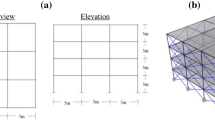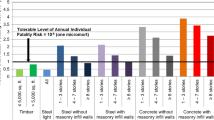Abstract
A probabilistic model is presented to obtain a realistic estimate of earthquake insurance rates for reinforced concrete buildings in Turkey. The model integrates information on seismic hazard and information on expected earthquake damage on engineering facilities in a systematic way, yielding to estimates of earthquake insurance premiums. In order to demonstrate the application of the proposed probabilistic method, earthquake insurance rates are computed for reinforced concrete buildings constructed in five cities located in different seismic zones of Turkey. The resulting rates are compared with the rates currently charged by the insurance companies. The earthquake insurance rates are observed to be sensitive to the assumptions on seismic hazard and damage probability matrices and to increase significantly with increasing violation of the code requirements.
Similar content being viewed by others
References
A. D. Akkaya M. S. Yucemen (2002) ArticleTitleStochastic modeling of earthquake occurrences and estimation of seismic hazard: A random field approach Probab. Eng. Mech. 17 1–13
A. Amendola Y. Ermoliev T. Y. Ermolieva V. Gitis G. Koff J. Linnerooth-Bayer (2000) ArticleTitleA systems approach to modeling catastrophic risk and insurability Nat. Hazards 21 381–393
Applied Technology Council: 1985, Earthquake Damage Evaluation Data for California, Report ATC-13, Redwood City, California.
Askan, A. and Yucemen, M. S.: 2003, Stochastic methods for the estimation of potential seismic damage. In: Proceedings of the Ninth International Conference on Application of Statistics and Probability in Civil Engineering,Berkeley, California, Vol. I, pp. 497–502.
R. Blong (2003a) ArticleTitleA review of damage intensity scales Nat. Hazards 29 57–76
R. Blong (2003b) ArticleTitleA new damage index Nat. Hazards 30 1–23
J. Bommer R. Spence M. Erdik S. Tabuchi N. Aydinoglu E. Booth D. del Re O. Peterken (2002) ArticleTitleDevelopment of an earthquake loss model for Turkish catastrophe insurance J. Seismol. 6 431–446
D. R. Brillinger (1993) ArticleTitleEarthquake Risk and Insurance Environmentrics 4 1–21
InstitutionalAuthorNameCode (1975) Specifications for Structures to be Built in Disaster Areas Earthquake Research Institute, Turkish Government Ministry of Reconstruction and Resettlement Ankara
C. A. Cornell (1968) ArticleTitleEngineering seismic risk analysis Bull. Seismol. Soc. Am. 58 IssueID5 1583–1606
C. A. Cornell S. R. Winterstein (1998) ArticleTitleTemporal and magnitude dependence in earthquake recurrence models Bull. Seismol. Soc. Am. 78 1522–1537
A. S. Elnashai (2000) ArticleTitleAnalysis of the damage potential of Kocaeli (Turkey) earthquake of 17 August 1999 Eng. Struct. 22 IssueID7 746–754
S. G. Ferraes (2003) ArticleTitleThe conditional probability of earthquake occurrence and the next large earthquake in Tokyo, Japan J. Seismol. 7 145–153
Gencoglu, S., Ozmen, B., and Guler, H.: 1996, Settlement Locations and Earthquake, Turkish Earthquake Foundation, Ankara (in Turkish).
Gulkan, P., Yucemen, M. S., Basoz, N., Kocyigit, A., and Doyuran, V.: 1993, Seismic Zoning Map for Turkey Based on the Most Recent Data, METU/EERC; Report No. 93–01, Ankara (in Turkish).
Gurpinar, A. and Yucemen, M. S.: 1980, An obligatory earthquake insurance model for Turkey, In: Proceedings of the International Conference on Engineering for Protection from Natural Disasters, Asian Institute of Technology, Bangkok, Thailand, pp. 895–906
Gurpinar, A., Abali, M., Yucemen, M. S., and Yesilcay, Y.: 1978, Feasibility of Obligatory Earthquake Insurance in Turkey, METU/ EERI Report No.78–05, Ankara (in Turkish).
B. Gutenberg C. Richter (1956) ArticleTitleEarthquake magnitude, intensity, energy and acceleration Bull. Seismol. Soc. Am. 46 105–143
W. B. Joyner D. M. Boore (1981) ArticleTitlePeak horizontal acceleration and velocity from strong motion records including records from the 1979 Imperial Valley California earthquake, Bull. Seismol. Soc. Am. 71 IssueID6 2011–2038
Kamei, K.: 1976, Japanese report on outline of earthquake insurance in Japan, In: UNESCO Conference on Assessment and Mitigation of Earthquake Risk, Paris.
H. Kunreuther (1996) ArticleTitleMitigating disaster losses through insurance J. Risk Uncertainty 12 171–187
Lockett, J. E.: 1980, Catastrophes and catastrophe insurances, J. Inst. Actuaries Student Soc. 24, 1980, 91–134.
C. Lomnitz (1974) Global Tectonics and Earthquake Risk Elsevier Amsterdam.
R. K. McGuire (2004) Seismic Hazard and Risk Analysis EERI MNO-10, California
Ozgur, C. and Yucemen, M. S.: 1997, Assessment of Seismic Hazard for Cyprus, Chamber of Civil Engineers, Report No.: UCCTEA/CCE-97–01, Nicosia.
Ozmen, B. and Bagcı, G.: 2000, 12 November 1999 Düzce Earthquake Report, Ministry of Public Works and Resettlement, General Directorate of Disaster Affairs, Earthquake Research Department, Ankara (in Turkish).
Scawthorn, C., Kunreuther, H., and Roth Jr, R.: 2003, Insurance and financial risk transfer, In: W.-F Chen. and C. Scawthorn (eds.), Earthquake Engineering Handbook, CRC Press, Chapter 32.
A. Smolka G. Berz (1989) ArticleTitleThe Mexico earthquake of September 19, 1985 – an analysis of the insured loss and implications for risk assessment Earthquake Spectra 5 223–248
A. Smolka G. Berz (1989) ArticleTitleThe Mexico earthquake of September 19, 1985 -- an analysis of the insured loss and implications for risk assessment Earthquake Spectra 5 223–248
L. Steven (1992) ArticleTitleThe earthquake and war damage commission – a look forward (and a look back) Bull. N. Z. Nat. Soc. Earthquake Eng. 25 52–55
E. Straub (1973) ArticleTitleEarthquakes and statistics from the insurance point of view, Bull Inter. Statist. Inst. 45 IssueID3 462–466
Sucuoglu, H. and Tokyay, M.: 1992, Engineering Report of 13 March 1992 Erzincan Earthquake, Turkish Society of Civil Engineers, Ankara (in Turkish).
M. D. Trifunac A. G. Brady (1975) ArticleTitleOn the correlation of seismic intensity scale with peaks of recorded ground motions Bull. Seismol. Soc. Am. 45 139–162
D. Vere Jones (1973) ArticleTitleThe statistical estimation of earthquake risk N. Z. Stat. 8 7–16
D. J. Wald V. Quitoriano T. H. Heaton H. Kanamori (1999) ArticleTitleRelationships between peak ground acceleration, peak ground velocity and modified Mercalli intensity in California Earthquake Spectra 15 IssueID3 557–564
Walker, G. R.: 2000, Earthquake engineering and insurance: past, present and future, Aon Re Australia (available on the Internet at: http://www.aon.com.au/reinsurance/knowledge/quake_engineering.asp).
Wasti, S. T. and Sucuoglu, H.: 1999, Rehabilitation of Moderately Damaged Reinforced Concrete Buildings after the 1 October 1995 Dinar Earthquake, METU/EERC, Report No. 99–01, Ankara (in Turkish).
R. V. Whitman (1973) Damage Probability Matrices for Prototype Buildings Dept. of Civil Engineering MIT, R73–57, Cambridge
M. S. Yucemen (1992) ArticleTitleSeismic hazard maps for Jordan and vicinity Nat. Hazards 6 IssueID3 201–226
M. S. Yucemen (1993) ArticleTitleA random field model for the estimation of seismic hazard Struct. Safety 12 187–203
Yucemen, M. S.: 2002, Prediction of potential seismic damage to reinforced concrete buildings based on damage probability matrices, In: Proceedings of the 6th International Conference on Concrete Technology for Developing Countries, Amman, Vol. 3, pp. 951–960.
M. S. Yucemen A. Akkaya (Dener) (1996) A comparative study of stochastic models for seismic hazard estimation M. I. El-Sabh S. Venkatesh H. Denis T. S. Murty (Eds) Land-Based and Marine Hazards NumberInSeries7 Kluwer Academic Publishers The Netherlands 5–24
M. S. Yucemen A. Askan (2003) Estimation of earthquake damage probabilities for reinforced concrete buildings S. T. Wasti G. Ozcebe (Eds) Seismic Assessment and Rehabilitation of Existing Buildings, NATO Science Series IV: Earth and Environmental Sciences. NumberInSeries29 Kluwer Academic Publishers The Netherlands 149–164
Yucemen, M. S. and Bulak, S.: 1997, Assessment of earthquake insurance premiums based on statistical methods, In: Proceedings of the Fourth National Earthquake Engineering Conference, Ankara, pp. 699–707 (in Turkish).
M. S. Yucemen S. Bulak (2000) ArticleTitleEstimation of earthquake damage on structures: damage probability matrices Bull. Chamb. Civil Eng. 3 15–22
M. S. Yucemen P. Gulkan (1994) ArticleTitleSeismic hazard analysis with randomly located sources Nat. Hazards 9 215–233
Author information
Authors and Affiliations
Corresponding author
Rights and permissions
About this article
Cite this article
YUCEMEN, M.S. Probabilistic Assessment of Earthquake Insurance Rates for Turkey. Nat Hazards 35, 291–313 (2005). https://doi.org/10.1007/s11069-004-6485-8
Received:
Accepted:
Issue Date:
DOI: https://doi.org/10.1007/s11069-004-6485-8




